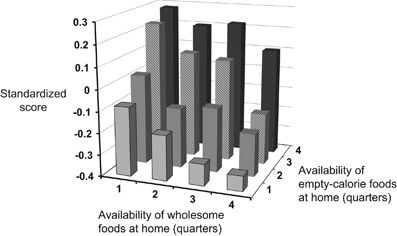International Journal of Obesity Supplements Pub Date : 2015-12-08 , DOI: 10.1038/ijosup.2015.22 H Vepsäläinen , , V Mikkilä , M Erkkola , S T Broyles , J-P Chaput , G Hu , R Kuriyan , A Kurpad , E V Lambert , C Maher , J Maia , V Matsudo , T Olds , V Onywera , O L Sarmiento , M Standage , M S Tremblay , C Tudor-Locke , P Zhao , T S Church , P T Katzmarzyk , M Fogelholm

|
Objectives:
We investigated the roles of home and school environments on dietary patterns among children from 12 countries differing widely in geographic region and levels of human and economic development.
Methods:
The sample included a total of 6685 (54% girls) 9–11-year-old children. Parents/guardians reported the availability of certain foods in the home, and trained researchers performed school audits recording the availability of foods for sale at schools. Foods were then divided into wholesome (nutrient-dense) and empty-calorie (nutrient-poor) foods and scored according to their availability. Children reported if their school provided school lunch and how many times during the last week they had eaten meals prepared away from home and school. Via principal components analysis, data-driven dietary pattern scores were calculated from food frequency questionnaires. Multilevel models were used to study the associations between home and school food environments (wholesome and empty-calorie foods) and dietary patterns (healthy and unhealthy diet pattern scores).
Results:
For low unhealthy diet pattern scores, low availability of empty-calorie foods at home was found to be more important than high availability of wholesome foods. More meals eaten outside home and school were associated with the higher unhealthy diet pattern scores. The availability of wholesome foods at home was positively associated with the healthy diet pattern scores. Food availability at school was not associated with the dietary patterns.
Conclusions:
In this sample, the home food environment was more significant than the school food environment in predicting the dietary patterns. The availability of empty-calorie foods was associated with the unhealthy dietary pattern even when the availability of wholesome foods at home was high. Meals prepared away from home contributed to the unhealthy dietary pattern. Therefore, parents should be encouraged to limit the availability of empty-calorie foods and eating outside the home.
中文翻译:

12个国家的9-11岁儿童的家庭和学校食物环境与饮食模式之间的关联
目标:
我们调查了家庭和学校环境对12个国家/地区儿童在饮食方式上的作用,这些儿童在地理区域以及人类和经济发展水平上差异很大。
方法:
样本总共包括6685名(11%的女孩)9-11岁的儿童。父母/监护人报告了家里某些食物的供应情况,训练有素的研究人员对学校进行了审核,记录了学校出售食物的可用性。然后将食物分为有益健康(营养丰富)和空热量(缺乏营养)食物,并根据其可获得性进行评分。孩子们报告他们的学校是否提供学校午餐,以及上周他们在离家和学校外准备的饭菜中吃了多少次。通过主成分分析,从食物频率问卷中计算出数据驱动的饮食模式得分。
结果:
对于不健康的饮食习惯得分较低,发现在家中空热量食物的低供应量比健康食物的高供应量更为重要。在家庭和学校以外的地方进食更多的膳食与较高的不健康饮食习惯得分相关。在家中提供有益健康的食物与健康的饮食习惯得分呈正相关。学校的食物供应与饮食习惯无关。
结论:
在此样本中,家庭饮食环境在预测饮食模式方面比学校饮食环境更为重要。空热量食品的供应与不健康的饮食习惯有关,即使在家中的有益健康食品的供应很高。出门在外做饭会导致不健康的饮食习惯。因此,应鼓励父母限制空热量食物的供应和在家外的饮食。









































 京公网安备 11010802027423号
京公网安备 11010802027423号